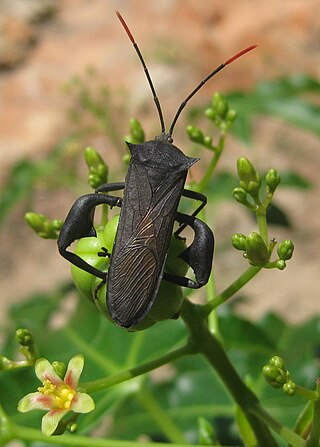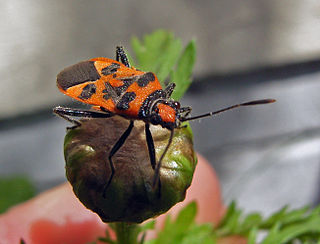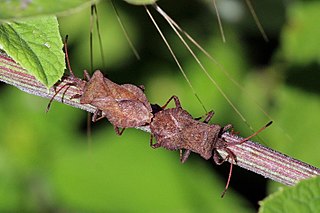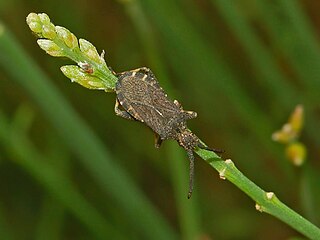
The western conifer seed bug, sometimes abbreviated as WCSB, is a species of true bug (Hemiptera) in the family Coreidae. It is native to North America west of the Rocky Mountains but has in recent times expanded its range to eastern North America, to include Ontario, Québec, New Brunswick, Nova Scotia, Michigan, Maine, Pennsylvania, New York, Connecticut, Massachusetts, and New Hampshire, and has become an accidental introduced species in parts of Europe and Argentina.

Anasa tristis is a species of bug in the family Coreidae. It is a major pest of squash and pumpkins, found throughout North America, and is a vector of the cucurbit yellow vine disease bacterium. These bugs can emit an unpleasant odor when disturbed. It is commonly known as the squash bug but shares this name with certain other species.

Coreidae is a large family of predominantly sap-sucking insects in the Hemipteran suborder Heteroptera. The name "Coreidae" derives from the genus Coreus, which derives from the Ancient Greek κόρις (kóris) meaning bedbug.

Coreoidea is a superfamily of true bugs in the infraorder Pentatomomorpha which includes leaf-footed bugs and allies. There are more than 3,300 described species in Coreoidea.

The Lygaeidae are a family in the Hemiptera, with more than 110 genera in four subfamilies. The family is commonly referred to as seed bugs, and less commonly, milkweed bugs, or ground bugs. However, while many of the species feed on seeds, some feed on sap (mucivory) or seed pods, others are omnivores and a few, such as the wekiu bug, are carnivores that feed exclusively on insects. Insects in this family are distributed across the world. The family was vastly larger, but numerous former subfamilies have been removed and given independent family status, including the Artheneidae, Blissidae, Cryptorhamphidae, Cymidae, Geocoridae, Heterogastridae, Ninidae, Oxycarenidae and Rhyparochromidae, which together constituted well over half of the former family.
Gelonus is a genus of leaf-footed bugs (Coreidae) in Tasmania, one of the few Coreidae that feeds on eucalypts. It is a member of the tribe Amorbini, but has only a single species, Gelonus tasmanicus(Le Guillou, 1841).
No. 519 Squadron RAF was a meteorological squadron of the Royal Air Force during the Second World War.

German submarine U-519 was a Type IXC U-boat of Nazi Germany's Kriegsmarine during World War II. She was laid down on 23 June 1941 at the Deutsche Werft yard in Hamburg as yard number 334, launched on 12 February 1942 and commissioned on 7 May 1942 under the command of Kapitänleutnant Günter Eppen.

Leptoglossus is a genus of true bugs in the leaf-footed bug family and the tribe Anisoscelini. Species are distributed throughout the Americas, with some records in eastern & southern Asia and Europe. Several species are economic pests of agricultural crops. Like members of some other genera in the family, these bugs have leaflike dilations of the hind tibia. Several species are of economic importance, and one species, L. chilensis, has been reported to bite humans.

Coreus marginatus is a herbivorous species of true bug in the family Coreidae. It is commonly known as the dock bug as it feeds on the leaves and seeds of docks and sorrels. It is a medium-sized speckled brown insect, between 13 and 15 mm long as an adult, with a broad abdomen. It occurs throughout Europe, Asia and northern Africa. It is often found in dense vegetation, such as hedgerows and wasteland.

Coreinae is a subfamily in the hemipteran family Coreidae. They have been shown to be paraphyletic with respect to Meropachyinae.

Leptoglossus oppositus a species of leaf-footed bug found in North America. It resembles Leptoglossus fulvicornis but can be distinguished by the deeper scallops in the leaf-like feature of the hind tibia and the addition of three white spots across the hemelytra. This species is widely dispersed from New York to Florida and as far west as Iowa and Minnesota, as well as the southwest regions of the United States into Mexico.

Chondrocera laticornis is a species of leaf-footed bugs in the family Coreidae. They can be found along the east coast of South Florida. They are characterized by the flattened leaf like tibia of its legs, the dilated and segmented 2 and 3 antennal segments.

Anisoscelini is a tribe of leaf-footed bugs in the family Coreidae. It was formerly spelled Anisoscelidini, but the tribal name spelling was incorrectly formed.

Physomerus grossipes, the sweetpotato bug or large spine-footed bug, is a species of Hemiptera in the family Coreidae. Native to Southeast Asia, the species has immigrated to the Pacific Islands. Frequently laying its eggs on the same Leguminosae and Convolvulaceae plants on which it feeds, the females of P. grossipes are very protective of their young, notably guarding both eggs and nymphs from predators.

Bothrostethus annulipes is a species of the Coreidae family, a subfamily of the Pseudophloeinae.

Thasus is an insect genus of the Coreidae, or leaf-footed bugs. It is a genus in the New World Nematopodini tribe that feeds on plants. It is chiefly found in Central America, but species also occur in South America, and as far north as the American Southwest.

Dalader is the type genus of coreid bugs in the Daladerini tribe. Species in the genus are distributed in tropical Asia, chiefly Southeast Asia. The genus name is derived from the Sanskrit roots dal meaning leaf and dhru which means bearer. This plant bug genus is distinguished by the which preterminal antennal segment being flattened, pear-shaped, and ridged and the terminal segment being paler. Chalcidoid egg parasites have been recorded from this species. Adults of Dalader acuticosta are fried and eaten in northeastern India.

The giant mesquite bug is an insect of the order Hemiptera, or the "true bugs". As a member of the family Coreidae, it is a leaf-footed bug. As the common name implies, it is a large bug that feeds on mesquite trees of the American Southwest and Northwestern Mexico.
















